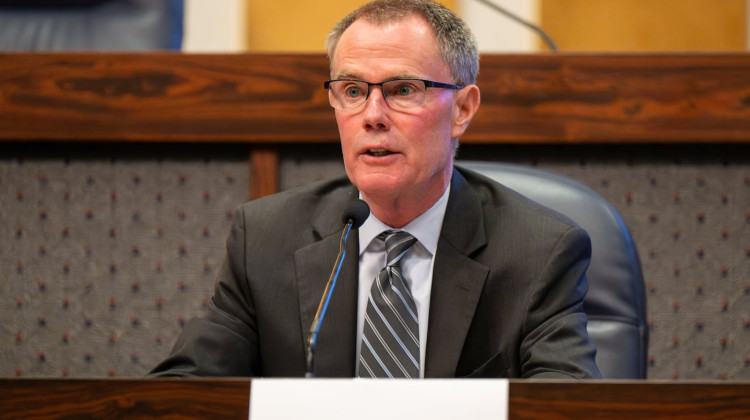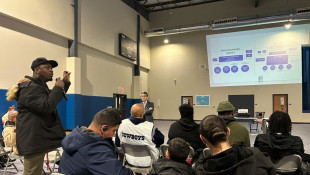
These parents believe that new funding could be a turning point for Gary Community Schools. From top left to bottom right: Kimberly Kimble, LeBarron Burton, Nina Burton, and Krystal Swain on the bleachers at West Side Leadership Academy on Sept. 10.
(Dylan Peers McCoy/WFYI)When Nina Burton was a student in Gary Community Schools in the 1980s, the district had close to 30,000 students and several high schools. It was known for its history of academic innovation.
“People came to our school system to see us,” said Burton, as she sat with a few other Gary parents on the bleachers at West Side Leadership Academy one afternoon earlier this month.
In the years since Burton graduated, however, Gary schools went through a financial free fall, as dwindling enrollment led to declines in state and federal funding. The district accumulated a $22 million operating deficit and more than $100 million in long-term debt by 2017 when Indiana lawmakers seized control.
But something remarkable is happening in Gary schools, which now enrolls about 4,800 students. The district is suddenly flush with money. Gary Community Schools was awarded nearly $68 million, about $14,000 per student, through two federal COVID relief bills earlier this year.
“We're really excited about what it's going to mean to really get the money that we should have had,” said Kimberly Kimble, who graduated from Gary schools 1987 and now has two children enrolled.
READ MORE: Here's How Much Each Indiana Public School District Is Receiving In Federal COVID Funding

The federal aid is just the latest windfall for the district. Voters approved a referendum a year ago to increase local property-tax funds for the schools by more than $71 million over eight years. Some of that money paid for the district’s first raise for teachers in years.
A state law passed last year also allows Gary schools to postpone about $25 million in payments on interest-free loans to the state. The money can be used to improve buildings or demolish shuttered schools.
Because of those funding increases and painful cuts — including closing schools and outsourcing services such as custodians — the Gary district is now financially stable. It's deficit last year was under $2 million.
“The focus isn't so much on finances anymore,” district manager Paige McNulty told parents in a video update this summer. “Now it's about the day-to-day runnings of the district, putting systems in place so that as we transition towards that local control goal at the end that we've got a great running school district.”
When state lawmakers stripped the locally elected school board of power, they placed the school system under the control of the Distressed Unit Appeals Board, which provides oversight to financially troubled districts and other government entities. The board hired MGT Consulting Group, based in Tallahassee, Florida, to run the district and make it fiscally sustainable.
MGT has not yet publicly shared its full, detailed plan for the new federal money. But the district has used some of the new money to fund an extra hour of each school day and to pay for stipends to staff.
The money will also help foot the bill for a massive list of building repairs that accumulated from years of underfunding. They include essential fixes to leaking roofs and unreliable heating, ventilation and air conditioning systems.

The pervasive building problems were obvious at a virtual meeting of the Distressed Unit Appeals Board in June. McNulty, who was logged on from an office in the district, said the roof leak was so bad she could see water running down the wall at that moment.
“We’ve had to close school twice since I've been here because of building issues,” McNulty said. “We had to kind of prioritize our huge needs.”
In August, shortly after the new school year began, three schools without functioning air conditioning were closed for days due to a heatwave in northwest Indiana.
The schools also have badly outdated athletic facilities. Before repairs earlier this year, the West Side track was dangerously pockmarked by decay. And the pool is in such disrepair it is closed. The district is also replacing the football field with artificial turf.
McNulty hopes these improvements will help Gary boost — or at least stabilize — enrollment, because it’s essential for the district’s long-term financial viability. In Indiana, the state funds schools on a per student basis.
The problems with facilities contributed to a cycle of deprivation in the Gary schools.
“If you don't have a good school system, then people that are moving into the area are going to send their kids somewhere else,” Kimble said. “Therefore the funding also decreases at the same time.”
“It's kind of a Catch-22 situation,” she added.
There are a few reasons Gary schools struggle with enrollment. The city of Gary has been shrinking for decades as jobs in the steel industry declined and White residents left the largely Black community. The population is about 69,000 now, down 14 percent from a decade ago.
But even many of the families with children who live in Gary shun the school district. More than half the public school students in its boundaries go to charter schools — which are independently managed — or to nearby districts.
It will be hard to win some of those parents back.
Kimmie Gordon enrolled her son in kindergarten before the takeover. Soon after, she decided to withdraw him because the district did not provide the services he needed for his learning disability.
That was six years ago, but Gordon is still wary.
"You get to the point where you're like, I only got one shot at this,” she said. “I just can't risk waiting for the Gary Community School to get it together.”

At a football game in early September, LeBarron Burton watched from the bleachers. His son plays tight end and middle linebacker for West Side.
LeBarron is Nina’s husband, and the couple have five children. The oldest ones used to attend a local charter school called Thea Bowman Academy — the same school the football team was facing off against.
When the Burtons decided to switch to district schools, their children were nervous that they wouldn’t be good, LeBarron Burton said. But they thrived, studying music and playing sports.
“I love going to Gary schools,” said Sarah Burton, who is now a senior at West Side. “It might not seem like it but it’s a lot of opportunities you have here.”
For the new money to benefit students for years to come it must also help the community, LeBarron Burton said. He wants the school system to hire local plumbers, electricians and professionals for the planned facility improvements.
“Those funds need to be regenerative,” he said. “One of my concerns is that that funding has a way of being recirculated back within the community so that we don't get in this position again later on.”
Upgrades to the football field and roof repairs won’t remake education in Gary. But residents hope the influx of new local and federal money will put the district on closer footing with the surrounding schools that it competes with for students.
Contact WFYI education reporter Dylan Peers McCoy at dmccoy@wfyi.org. Follow on Twitter: @dylanpmccoy.
 DONATE
DONATE







 View More Articles
View More Articles

 Support WFYI. We can't do it without you.
Support WFYI. We can't do it without you.